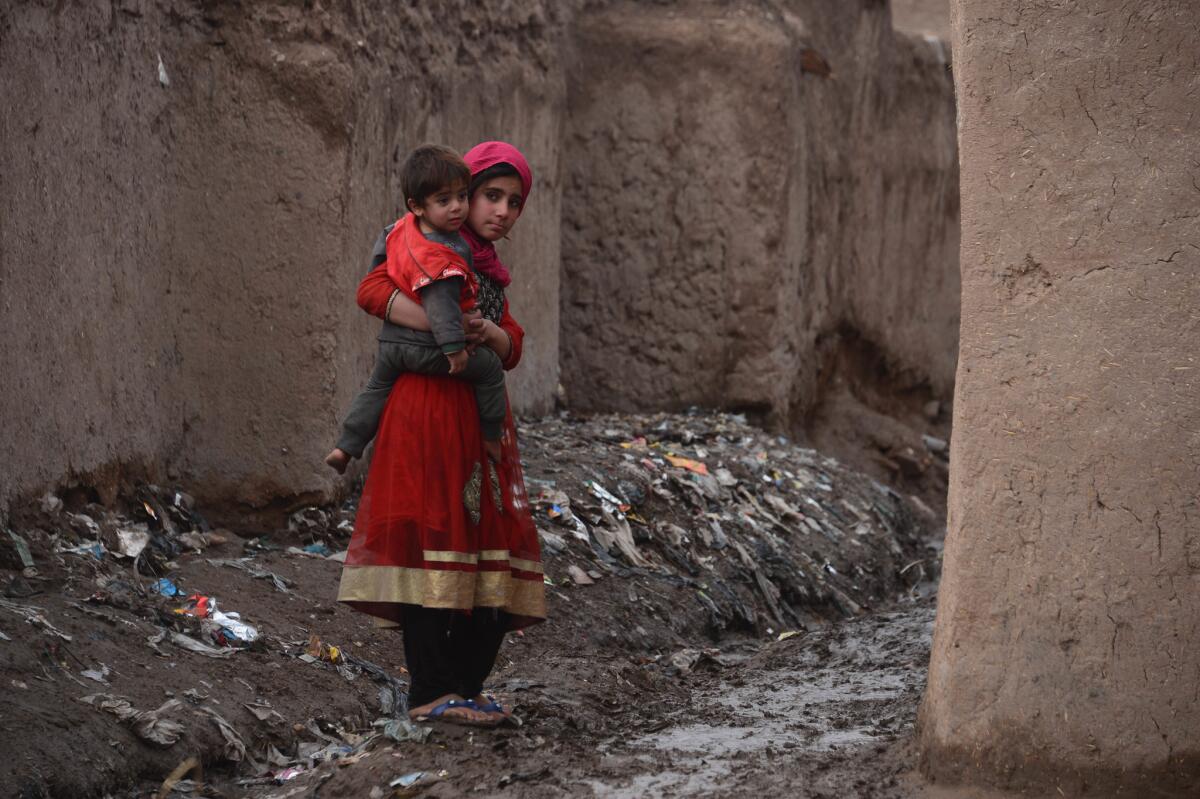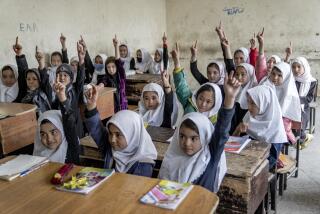Record number of children killed in Afghanistan conflict in 2016, U.N. says

- Share via
Reporting from KABUL, Afghanistan — The United Nations has reported that 923 children in Afghanistan were killed last year, a 25% increase from 2015 and the most since the U.N. began keeping track seven years ago.
An additional 2,589 children were injured, a 23% rise that was also a record high.
The totals, released Monday, were another sign that the largely forgotten war in Afghanistan is taking a growing toll on civilians. The last year saw a rise in fighting in populated areas, increased attacks by Islamic State militants, more airstrikes and greater civilian exposure to land mines.
Apart from a slight dip in 2012, the number of civilians of all ages killed or wounded has risen each year since 2009, when the U.N. began keeping those statistics. The casualty total — which consists of deaths and injuries — climbed 3% to 11,418.
The disproportionate increase in child deaths was due mainly to a 66% increase in casualties from land mines and other buried munitions. Most of those victims were children, the U.N. report said.
Young Afghans were also victimized in ground battles between U.S.-backed Afghan forces and insurgents, mainly from the Taliban. With 390 child deaths and 1,371 injuries caused by ground fighting, the casualty total climbed 23% from 2015.
“This appalling conflict destroys lives and tears communities apart in every corner of Afghanistan,” Tadamichi Yamamoto, the ranking U.N. official in Kabul, said in a statement accompanying the report.
With U.S.-led international forces operating mainly in an advisory role, and a third of Afghanistan’s population either living under Taliban control or in contested areas, ground battles are becoming increasingly frequent and deadly.
The U.N. attributed 61% of civilian deaths and injuries to Taliban and other insurgent groups and 24% to government forces, with smaller proportions blamed on foreign troops and pro-government militias.
President Ashraf Ghani’s office said that he welcomed the report but that security forces already take measures to protect civilians.
“Despite the Taliban and other terrorist groups, the government is committed to protecting the lives and wealth of its citizens and is committed to accountability,” it said in a statement.
The Taliban, which has consistently rejected the U.N.’s findings that it is responsible for most of the casualties, issued a statement saying it denied the report.
“All sides of the conflict have usually said that they will take measures to prevent civilian casualties, but they never follow up with it,” said Atiqullah Amarkhail, a military affairs expert in Kabul.
The growing toll was also due to increased attacks by fighters loyal to Islamic State, the Sunni Muslim militant group based in Iraq and Syria, which has mainly attacked minority Shiite Muslims. The U.N. counted 209 people killed and 690 injured in attacks attributed to Islamic State supporters, a tenfold increase from the previous year.
Most of the casualties were the result of three large attacks, the biggest coming in July when 80 people were killed and hundreds wounded in the bombing of a protest by the Hazara ethnic group, who are Shiites.
In response to the widening threat from Islamic State, as well as the Taliban, then-President Obama expanded the U.S. military’s authority to conduct airstrikes in Afghanistan. That has also led to civilian casualties last year, with Afghan and international airstrikes responsible for 250 deaths and 340 injuries — a doubling of the 2015 casualty count.
Since 2009, fighting in Afghanistan has killed 24,841 civilians and injured 45,347 others, the report said.
Special correspondent Faizy reported from Kabul, Afghanistan, and staff writer Bengali from Rome.
Follow @SBengali on Twitter for more news from South Asia
MORE WORLD NEWS
In Mexico, Trump triggers a surge in patriotism, anti-American sentiment
UPDATES:
1:40 p.m.: This story was updated throughout with staff reporting.
This article was originally published at 4:40 a.m.
More to Read
Sign up for Essential California
The most important California stories and recommendations in your inbox every morning.
You may occasionally receive promotional content from the Los Angeles Times.











